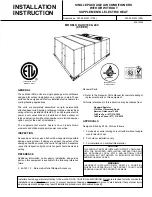
- 88 -
1. Routine maintenance checks
•
Periodically and thoroughly check the circulating water circuit. (See table below.)
•
Consult a maintenance technician.
2. Parts Replacement Cycle
Components
Refrigerant
circuit
components
Electric circuit
parts
What to look for
Maintenance cycle
(times/year)
Replacement cycle
Compressor
Water-refrigerant heat exchanger
Solenoid valve
(PWFY-P100, 200VM-E1/E2-AU)
Check valve
(PWFY-P100, 200VM-E1/E2-AU)
Linear expansion valve
Strainer
Capillary tube
Pipes
Electromagnetic contactor
Overcurrent relay
Relay
Solenoid valve
Fuse
Electronic board
Switch
Pressure switch
Terminal block
Cable/connector
Fan
Motor
High/low pressure, vibration, noise
Insulation resistance, loose terminals
High/low pressure, water pressure loss
Operation, leakage, clogging
Operation, leakage, clogging
Operation
Inlet/outlet temperature difference
Contact wear, Vibration
Contact wear, Vibration
Corroded contact, loose terminals
Insulation resistance
loose terminals
Operation, Contact resistance.
Insulation resistance
Insulation resistance
External appearance
External appearance
Operation, Contact resistance.
Contact resistance.
loose terminals
Looseness, corrosion, and wearing
Balance
Insulation resistance, noise, vibration
20,000 hours
10 Years
7 Years
10 Years
7 Years
While in heavy use
10 Years
10 Years
8 Years
7 to 10Years
6 Years
7 Years
8 Years
8 Years
8 Years
7 to 10Years
8 Years
10 Years
10 Years
6 to 10Years
2
2
2
1
2
1
1
1
2
2
2
2
2
2
2
2
2
2
2
2
Regular preventive maintenance and parts replacement help keep the unit running smoothly and minimize problems.
The table below shows the maintenance schedule. Use the replacement timing in the table only as a guide. Some parts
may need to be replaced sooner, depending on the usage.
Maintenance Cycle
VII
















































